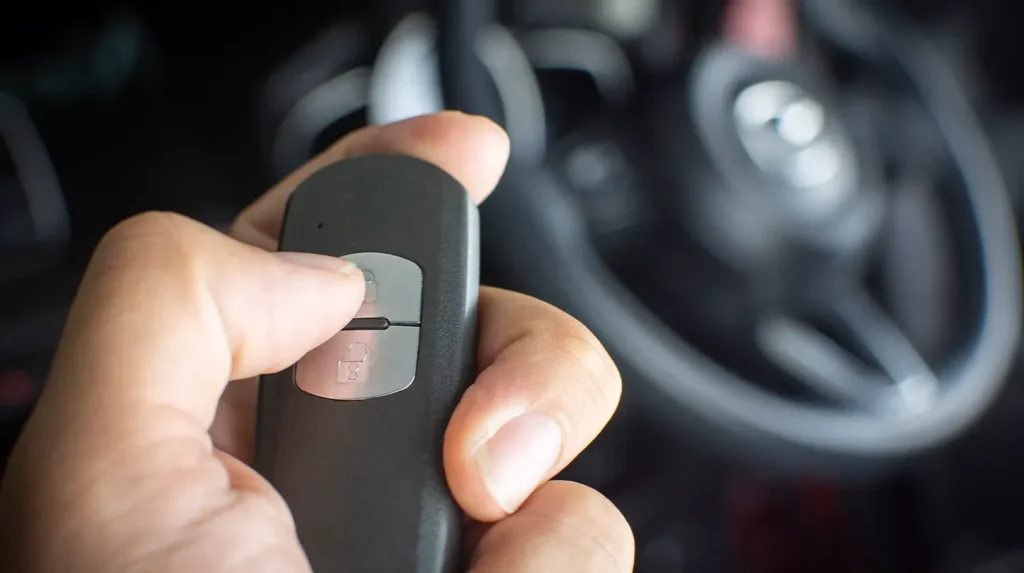Want to prevent car theft without lifting a finger? A passive disabling device is an anti–theft system that secures your car as soon as you turn off the engine and walk away, with no manual activation on your part required. In this article, we’ll explain passive disabling devices, their role in car security, different types, how they work, their benefits, and a comparison with active anti-theft devices. Understanding these technologies can help you protect your vehicle from theft and potentially lower your insurance premiums.
We’ll also cover how auto dealerships, public parking lot owners and operators, auto storage facilities, boat yards, and other commercial properties with large numbers of vehicles can proactively protect their inventory and outdoor assets from vehicle theft.
Key Takeaways
- Passive disabling devices secure your car when you leave, providing hands-free protection against theft.
- These devices use key recognition technology to prevent unauthorized starts, so they’re effective and reliable.
- Installing passive disabling devices can lower your car insurance premiums as anti-theft devices affect the risk assessment by insurance companies, reducing the risk of theft.
Understanding the Passive Disabling Device for Enhanced Car Security
Passive disabling devices play an important role in vehicle security, engaging as soon as the engine is turned off and the vehicle is exited. Picture parking your car, walking away, and knowing it’s instantly protected without any effort on your part.
These devices use key recognition technology. Each key fob has a unique code that the system recognizes. Only the correct key can start the car, providing extra security. In addition to passive disabling devices, steering wheel locks are another anti-theft measure that physically prevents the car from being driven away. Passive alarm systems kick in when the car is locked and the driver walks away, making these devices a robust deterrent to theft, similar to a car alarm.
In 2022, vehicle theft reached over one million reported cases, marking a significant rise, though vehicle theft rates in general have steadily increased since 2019, and 2023 proved to be another record-breaking year. This increase highlights the growing need for advanced security measures to protect our vehicles. Car owners must now be more vigilant than ever, ensuring their vehicles are equipped with the latest anti-theft technologies.
Unfortunately, thieves have steadily become more innovative in their methods for getting around solutions like passive disabling devices. Devices like signal interceptors can “clone” the key fob, allowing criminals to get into vehicles without setting off alarms.
What is a Passive Disabling Device?

Passive disabling devices are part of modern car security systems. Unlike an active disabling device that needs to be manually activated, passive disabling devices operate automatically, engaging as soon as the engine is turned off and the car is left. No driver effort required.
These devices use advanced key recognition technology to prevent unauthorized engine starts. Each key fob has a unique code that the system recognizes, so only the correct key can start the car. This is common in most modern cars so passive disabling devices are a standard security feature. For example, BMWs are famous for their immobilizers which are a big step up in vehicle security.
Types of Passive Disabling Devices
There are several types of passive disabling devices, immobilizers, passive door locks and audible alarms that play a big part in protecting vehicles from theft. Each type has its own features and benefits which we will cover in the following sections to help you choose the right anti-theft device for your car. Knowing these types will help you choose the right anti-theft device for your car.
Immobilizers
Immobilizers are powerful passive anti-theft devices and prevent the engine from starting without the correct key. For example, the PASS Lock system locks the ignition when the car is off, so only the correct key can start the engine. This is a big deterrent to car thieves who use hotwiring or other methods.
A practical example is the Honda Civic which has a chip embedded in the key within its immobilizer system. The car’s computer must recognize the chip in the key to start the car, so it’s almost impossible for thieves to start the car without the correct key, reducing theft risk.
Passive Door Locks
Many cars with remote keyless entry have passive door locks that engage when the engine is off. This feature locks all doors as soon as the driver walks away. Systems like PASS Lock locks the doors when the key fob moves a certain distance from the car.
Modern cars, especially GM models, have passive door locking. This is convenient as you don’t need to manually lock the doors, so the car is always secure when left unattended.
Audible Alarms
Audible alarms are another type of passive disabling device that engages when the car is locked. They make a loud noise when they detect a threat, such as a break-in or movement around the car. The noise ideally draws attention to the theft and scares the thief away.
Unlike an active alarm that needs to be manually activated, passive devices arm themselves when the car is locked. So, the car is always protected even if the driver forgets to arm the alarm manually.
How Passive Disabling Devices Work
Passive disabling devices engage automatically without the user’s intervention when the car is turned off or the ignition key is removed. As soon as you park and walk away the system activates, it’s immediate protection. Common features are automatic door locking and disabling the fuel supply if an incorrect key is used, like the PASSLock system.
A key feature of these systems is automatic activation when the car is locked, key is removed or when the key is a certain distance from the car. For example some cars have automatic door locks that engage when the car is in motion or after a certain time.
These features are hassle free and reliable. You don’t need to remember to activate the system, it works independently so your car is always secure. This is the main reason why passive disabling devices are effective.
Benefits of Using Passive Disabling Devices
A big benefit of passive disabling devices is they are easy to use. No manual intervention is required to activate, so it simplifies security for car owners. So, you can sleep tight knowing your car is protected without remembering to activate anything.
And these devices work independently of electronic systems, so they work even during power outages. They add layers of security that will deter thieves so car owners can have peace of mind.
Comparing Passive and Active Anti-Theft Devices
The main difference between passive and active anti-theft devices is activation. Passive devices activate when you lock the car, active disabling device needs manual intervention from the driver.
This difference is a big deal for user convenience and overall security.
Activation Process
The activation process of passive disabling devices is simple and automatic. They engage without any user input. For example, as soon as you park and lock the doors the passive system activates, it’s immediate protection.
Conversely active anti-theft devices need manual activation by the user before leaving the car. This means you need to remember to activate the system which can be inconvenient and a security risk if forgotten.
Security Effectiveness
Regarding security effectiveness, passive anti-theft systems are generally considered more effective in preventing theft because of the automatic activation. These systems are always on, no need to rely on user memory or intervention.
But active disabling devices can offer a stronger defense against theft because they need manual activation and can deter and delay theft attempts better. For example, the PASSLock system can activate Long Tamper Mode after several failed starting attempts to deter would-be thieves.
The effectiveness of both systems varies by vehicle model and manufacturer, but passive devices are generally always on.
Vehicle Compatibility with Passive Disabling Devices
Most modern cars, especially those made in the last decade, have passive disabling systems. These are built into the vehicle’s security system so it’s seamless. Models like Honda Civic, Tesla, Mazda and BMW have passive disabling features built in to their security.
Installing modern immobilizers to older vehicles, on the other hand, requires major modifications to their electrical system which is a big task. The complexity of passive disabling technologies varies by model and manufacturer, but the benefits are worth it for vehicle security.
How Do Passive Disabling Devices Affect Car Insurance Premiums?
Passive disabling devices can lower car insurance premiums because of how anti-theft devices affect the risk assessment of insurance companies. Insurance companies offer discounts for vehicles with these devices because they lower the theft risk, so it’s a good addition to your car’s security features.
Vehicles without standard immobilizers may have higher premiums or may not be covered by insurance. So, installing passive disabling devices not only adds security but can also save you on insurance costs.
Additional Tips for Preventing Car Theft

Passive disabling devices like immobilizers can deter casual thieves but not skilled thieves with advanced techniques. To further protect your vehicle, consider additional security measures like GPS tracking systems which can give you higher insurance discounts than other anti-theft devices.
Etching your initials near the VIN or inside the trunk/hood can make your vehicle easier to recover if stolen. And comparing rates from several insurance companies can help you find the best discounts for different anti-theft devices.
Ultimately, passive disabling devices are a part of modern vehicle security. Their automatic activation and key recognition technology is seamless and doesn’t require any user intervention. Now that you know the different types of passive disabling devices and their benefits, you can make an informed decision to add security to your vehicle.
These devices can also lower insurance premiums, so they have financial and security benefits. Installing passive disabling devices is a smart move for any car owner who wants to protect their vehicle from theft.
Commercial Auto Dealership Security: Remote Video Monitoring

While passive disabling devices play a crucial role in modern vehicle security, they apply to individual vehicles themselves. Their automatic activation and key recognition technology can potentially provide seamless protection without requiring any manual intervention, and by understanding the different types of passive disabling devices and their benefits, you can make an informed decision to enhance your personal vehicle’s security.
But how can you protect large numbers of vehicles from theft simultaneously, in applications like auto dealerships, parking garages, storage lots, service lanes, and other commercial applications?
The Advantages of Video Surveillance & Remote Video Monitoring

Automotive dealerships can significantly benefit from integrating remote video monitoring into their security strategies. Here’s how:
- Proactive Security Measures: Remote video monitoring empowers dealerships to identify and react to potential threats instantly, preventing damage before it occurs.
- Substantial Reduction in Crime Rates: Research indicates that the presence of video monitoring can decrease crime rates by up to 50%, making it an invaluable asset for safeguarding assets.
- Enhanced Police Response Times: Thanks to strategic partnerships with law enforcement agencies across North America, Stealth Monitoring ensures quicker police responses. Law enforcement officers are more responsive when they receive verified video evidence of a crime in progress from Stealth Monitoring.
- Cost-effective Security Solutions: Opting for video surveillance and remote monitoring presents a cost-effective alternative to traditional security methods. It offers the benefits of continuous security without the associated costs of staffing full-time security personnel.
- Peace of Mind: Employ a team of expert monitoring operators to oversee your dealership, ensuring that your property, inventory, and other valuable assets are secure. This allows dealership owners and managers to focus on business growth with fewer worries about security risks.
For comprehensive insights on protecting Infiniti, Hyundai, Kia, and other luxury or high-performance vehicles, we invite you to obtain your complimentary guide, 9 Simple Steps to Secure Your Dealership Lot. Still have questions? Contact us.
Frequently Asked Questions
What are passive disabling devices?
Passive disabling devices are automatic anti-theft systems that kick in without you having to do anything, ensuring your vehicle stays protected effortlessly.
How do passive disabling devices work?
Passive disabling devices work by automatically activating when you turn off the vehicle, remove the key, or lock the doors, using key recognition tech to stop anyone from starting the engine without permission. It’s a handy way to keep your ride secure!
What are the benefits of using passive disabling devices?
Using passive disabling devices is a smart move because they provide convenience and reliability, plus they can help lower your car insurance by reducing theft risks. It’s a win-win for peace of mind and savings!
How do passive disabling devices compare to active disabling devices?
Passive disabling devices are great because they work automatically and provide constant protection. In contrast, active devices can offer stronger defense but need you to remember to activate them.
Can passive disabling devices lower my car insurance premiums?
Absolutely! Having passive disabling devices in your car can often lead to discounts on your insurance premiums since they lower the chances of theft.
Texas Private Security License Number: B14187
California Alarm Operator License Number: ACO7876
Florida Alarm System Contractor I License Number: EF20001598
Tennessee Alarm Contracting Company License Number: 2294
Virginia Private Security Services Business License Number: 11-19499
Alabama Electronic Security License # 002116
Canada TSBC License: LEL0200704

